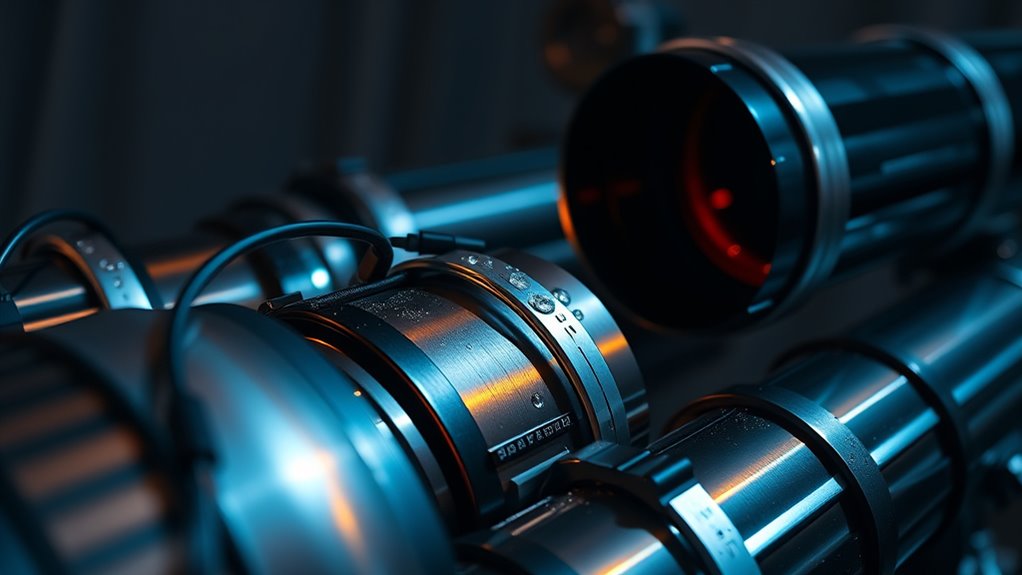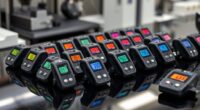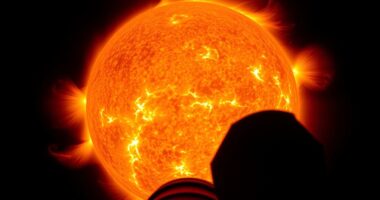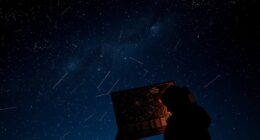I know how frustrating dew can be during stargazing or astrophotography. The best dew heaters, like the Celestron Dew Heater Ring for 8-inch scopes or larger strips for big telescopes, guarantee your view stays clear and bright. Compact USB options are perfect for DSLR lenses, while heavier-duty strips suit larger setups. If you want reliable dew prevention tailored to your equipment, there’s plenty more to think about—keep going to find the perfect solution for your needs.
Key Takeaways
- Choose custom-fit dew heater rings or strips designed for your telescope size and type to ensure effective dew prevention.
- Look for models with adjustable power modes, rapid heating, and even heat distribution to maintain clear optical views.
- Prioritize durable, weather-resistant materials like neoprene, silicone, or aluminum for outdoor reliability.
- Consider power options such as 12V DC or USB for portability and compatibility with your existing power sources.
- Check for safety features like overheat protection and proper sizing to ensure safe, efficient operation and optimal dew control.
Celestron Dew Heater Ring for 8” Telescopes
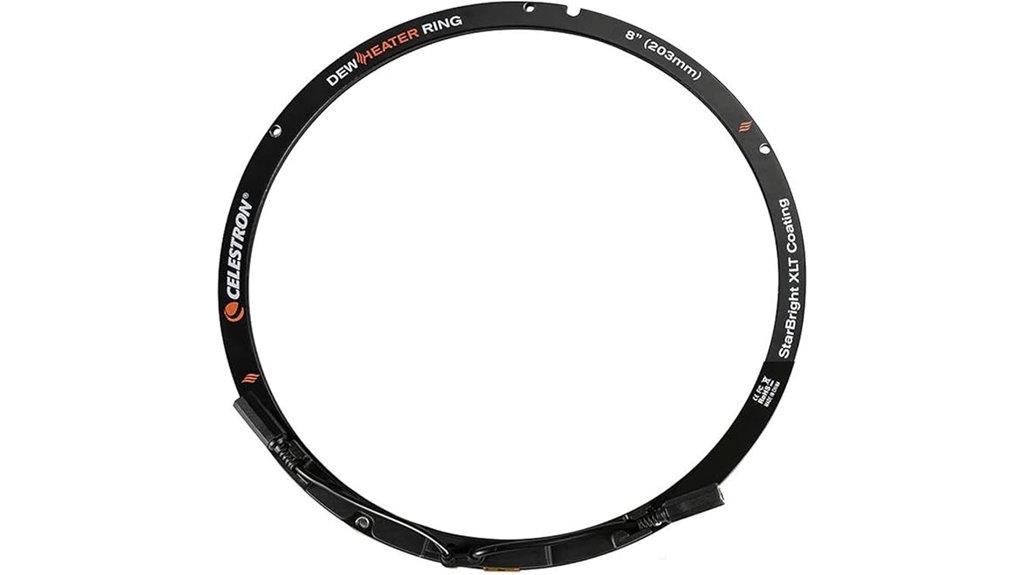
If you’re using an 8-inch Celestron telescope and want reliable dew prevention, the Celestron Dew Heater Ring is an excellent choice. I’ve found it to be easy to install and highly effective at keeping dew off my Schmidt-Cassegrain and EdgeHD models. Made from lightweight aluminum, it fits securely and provides uniform heating across the corrector lens. It connects effortlessly to a 12V power source and includes cable management clips for organization. With a solid 4.6-star rating from over 250 reviews, it’s praised for durability and ease of use. This dew heater ring ensures clear views, even in damp or chilly conditions.
Best For: amateur astronomers and astrophotographers using 8-inch Celestron telescopes who need reliable dew prevention during observing or imaging sessions.
Pros:
- Efficient and uniform heating to prevent dew formation on the corrector lens
- Easy to install and connect to a 12V power source
- Durable, lightweight aluminum construction with cable management clips for organization
Cons:
- Designed specifically for 8-inch Celestron models, limiting compatibility with other sizes or brands
- Requires an external 12V power source, which may necessitate additional equipment
- Slightly higher cost compared to basic dew prevention solutions
SVBONY SV192 Dew Heater Strip for Telescope and Camera Lenses

The SVBONY SV192 Dew Heater Strip stands out as an excellent choice for astronomers with large aperture lenses and telescopes, thanks to its 560mm length and compatibility with devices up to 178mm in diameter. Its narrow 50mm width ensures it won’t interfere with focusing or accessories, while built-in aluminum provides even, rapid heating. With adjustable temperature modes—strong, medium, and weak—it heats quickly and efficiently, maintaining focus without darkening the view. Easy to attach with Velcro and supplied with a 120cm power cord, it’s reliable, durable, and well-suited for winter and humid conditions. This makes it a valuable tool for keeping your lenses dew-free.
Best For: astronomers with large aperture lenses and telescopes seeking an effective, easy-to-use dew prevention solution.
Pros:
- Even and rapid heating thanks to built-in aluminum and alloy fiber wiring.
- Narrow 50mm width prevents interference with focusing and accessories.
- Adjustable temperature modes for customized dew prevention in various conditions.
Cons:
- Lacks USB ports, requiring adapters for USB connectivity.
- Limited to devices with outer diameters below 178mm, restricting some larger equipment.
- May require additional mounting accessories like elastic bands or Velcro for secure attachment.
NEEWER USB Lens Heater for DSLR and Telescope
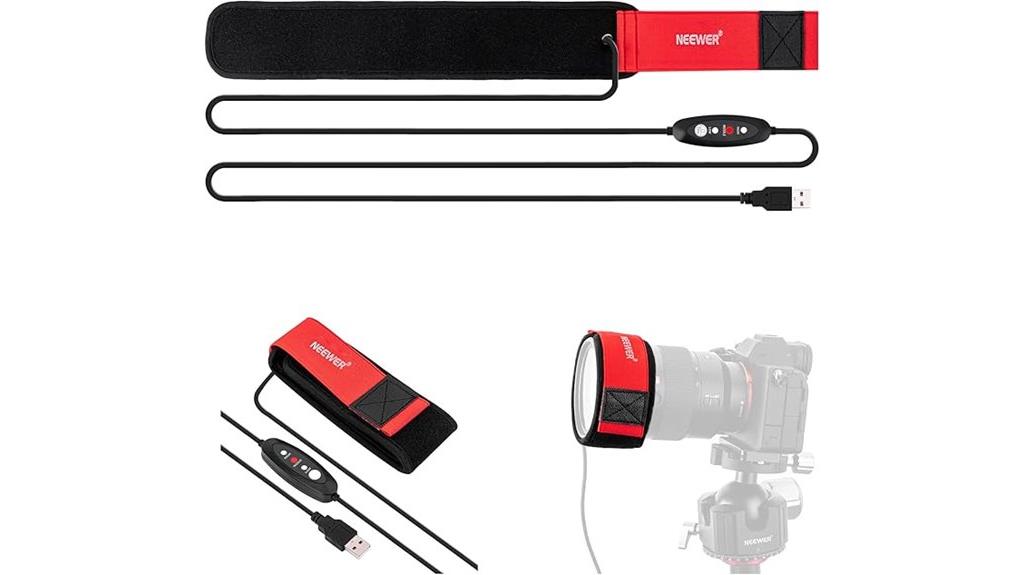
Designed specifically for DSLR cameras and telescopes, the NEEWER USB Lens Heater effectively prevents dew, fog, and condensation during cold weather astrophotography. Its 12/300mm length fits lenses or scopes up to 10.8 inches in circumference, and the hook and loop fasteners allow secure, adjustable wrapping. Powered via a 5V 2A USB source, it offers three temperature settings—high, middle, and low—so you can adapt to environmental conditions. Lightweight at just over 3.5 ounces, it’s easy to handle and use outdoors. With positive reviews and a solid rating of 4.5 stars, it’s a reliable choice to keep your view bright and clear.
Best For: Amateur and professional astrophotographers, DSLR camera users, and telescope enthusiasts seeking effective dew prevention during cold weather imaging.
Pros:
- Adjustable temperature settings (High, Middle, Low) for optimal performance in varying conditions
- Lightweight and easy to handle, weighing just over 3.5 ounces for outdoor portability
- Flexible 4.9ft USB cable and secure hook-and-loop fasteners for easy wrapping around lenses and scopes
Cons:
- Limited to lenses or scopes with a circumference up to 10.8 inches, not suitable for larger equipment
- Requires a 5V 2A USB power source, which may necessitate additional adapters or portable chargers
- May need careful adjustment of temperature settings to prevent overheating or insufficient warming
SVBONY SV172 Lens Warmer, 400mm Dew Heater Strip for Telescope Camera
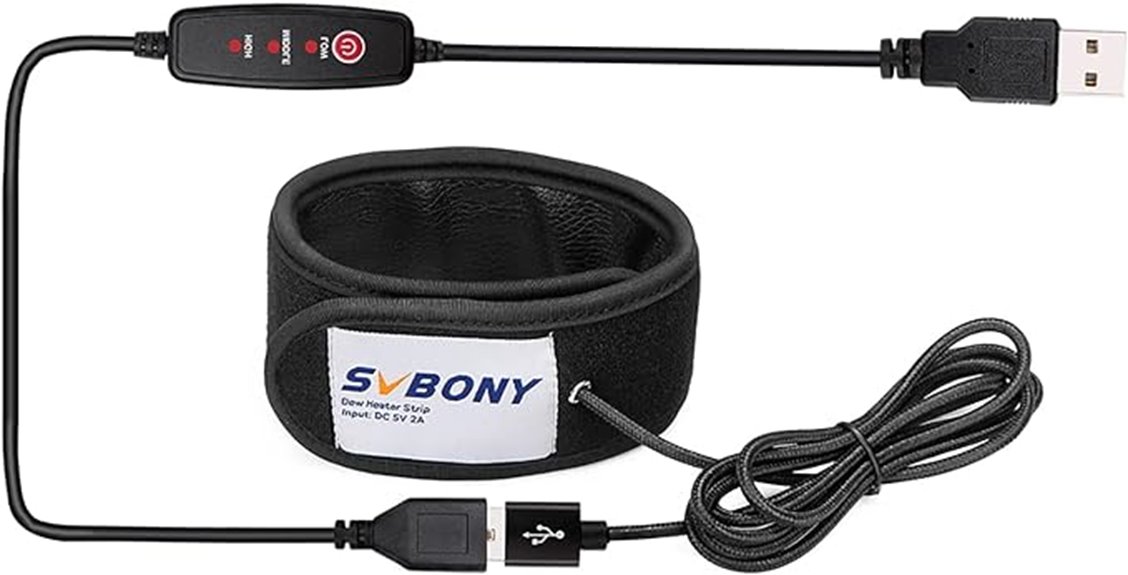
For amateur astronomers seeking an effective and versatile dew prevention solution, the SVBONY SV172 Lens Warmer stands out. This 400mm heater strip fits lenses under 127mm in diameter, making it compatible with telescope optics, guide scopes, and even water bottles. Its even heat distribution and quick warming help prevent fogging in cold conditions, and the adjustable three-gear temperature control offers tailored heating. Powered via USB, it’s easy to use with various power sources, and the Velcro strap guarantees secure attachment. Many users praise its performance and value, though some note sensitivity to power quality. Overall, it’s a reliable choice for keeping your view bright and clear.
Best For: amateur astronomers and astrophotographers seeking an effective, adjustable dew prevention solution for telescope lenses and accessories.
Pros:
- Even heat distribution with rapid warming capabilities
- Adjustable three-gear temperature control for tailored heating
- Versatile use on various optical equipment and water bottles
Cons:
- Sensitive to power source quality, potentially affecting performance
- Some users report controller malfunctions or overheating over extended use
- Limited compatibility with lenses larger than 127mm in diameter
Dew Heater Strip for 11” Telescopes
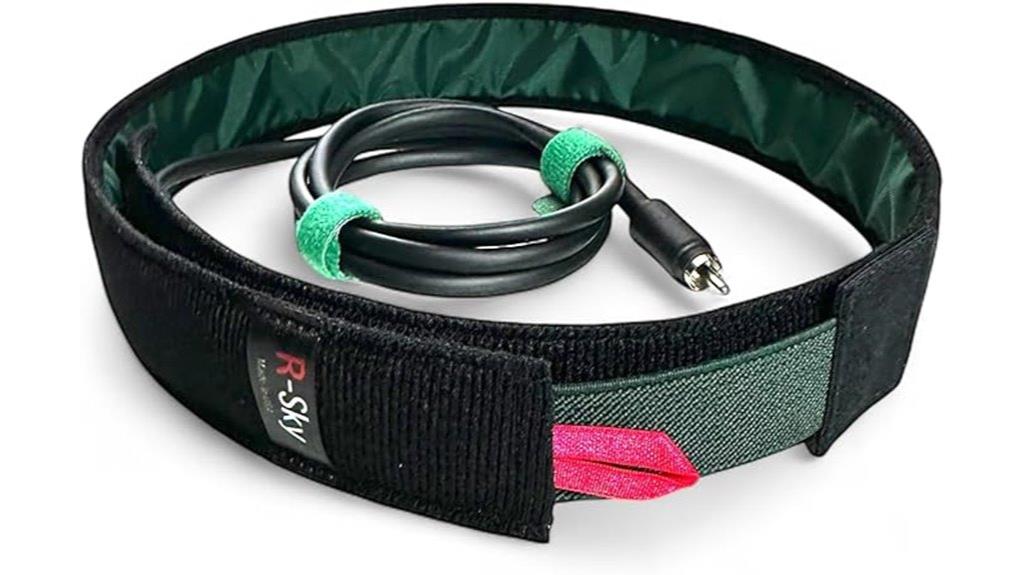
If you’re using an 11” telescope and want reliable dew prevention, the Dew Heater Strip from R-Sky offers targeted heating that keeps your corrector plates clear. Designed specifically for 11” optical systems, it effectively prevents dew formation on lenses and corrector plates. The strip features even heat distribution, eliminating hot spots and maintaining a consistent temperature. Hand-assembled by R-Sky, it’s made with a soft, durable 47-inch cord that stays flexible even in cold weather. Its tangle-free design makes setup straightforward, ensuring dependable performance during your observing sessions. This heater strip is built to last and keep your view bright and clear.
Best For: astronomers and stargazers using 11” telescopes who need reliable dew prevention on their corrector plates and lenses during outdoor observing sessions.
Pros:
- Effectively prevents dew formation with targeted, even heating
- Made with a soft, flexible cord that remains pliable in cold weather
- Tangle-free design allows for quick and easy setup in the field
Cons:
- Designed specifically for 11” optical systems, limiting compatibility with other sizes
- Requires a compatible dew controller and power source with a standard RCA 12V plug
- Hand-assembled, which may lead to slight variability in production quality
Dew Heater Strip for 7–8” Telescopes
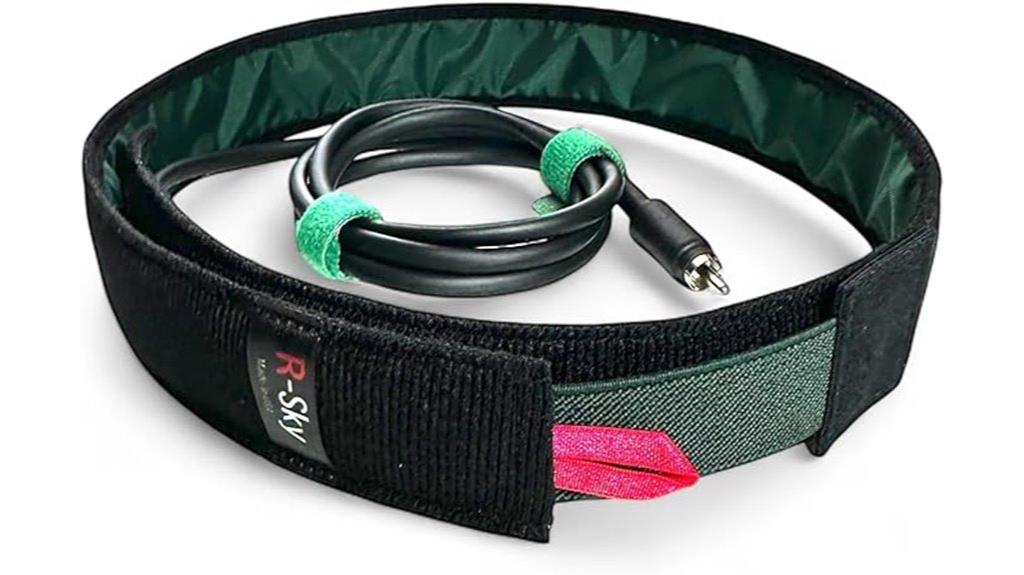
The Dew Heater Strip for 7–8” telescopes offers reliable anti-dew performance with a uniform heating surface that prevents hot spots and heat loss. It’s compatible with SCT and Maksutov optical tubes, making it versatile for mid-size telescopes. The strip features a soft, flexible cord measuring 47 inches, ensuring easy installation and flexibility. Its design is resistant to freezing temperatures, so it performs well in harsh weather. Powered via a standard RCA 12V plug, it works seamlessly with most dew controllers. Overall, this heater strip provides consistent, even warmth, helping you maintain clear views during humid nights.
Best For: amateur astronomers and stargazing enthusiasts with 7–8” telescopes seeking reliable dew prevention in high humidity and cold weather conditions.
Pros:
- Provides uniform heating surface to prevent hot spots and heat loss.
- Compatible with SCT and Maksutov optical tubes for versatile use.
- Durable, resistant to freezing temperatures, and easy to install with a flexible 47-inch cord.
Cons:
- Requires a compatible dew controller with a standard RCA 12V plug.
- May need additional insulation or mounting accessories for optimal placement.
- Designed specifically for 7–8” telescopes, limiting use with smaller or larger models.
Lens Warmer, LOSHARP Dew Heater for Telescope Lens Heating
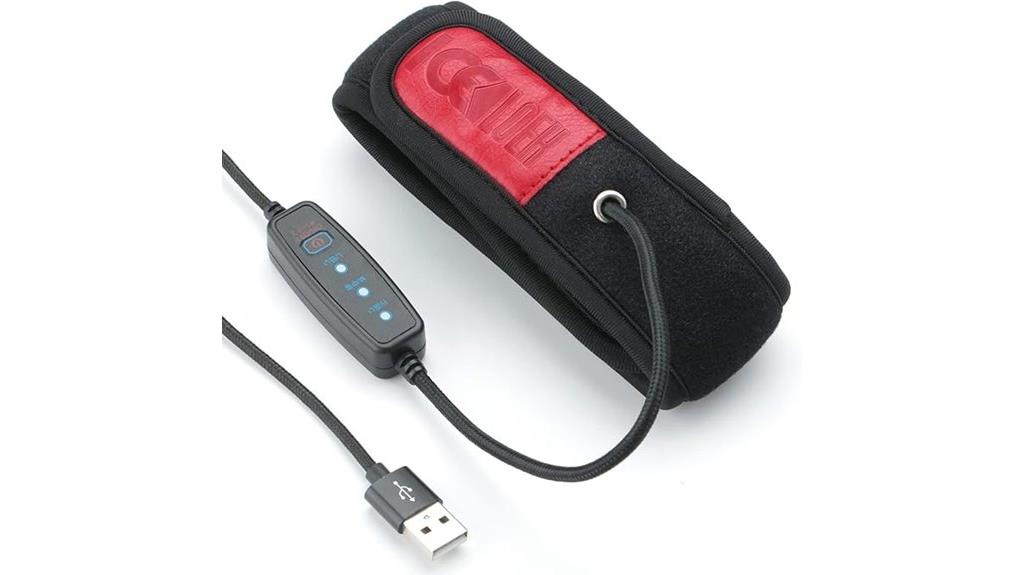
Anyone looking to keep their telescope lenses clear during chilly nights will find the LOSHARP Dew Heater an essential tool. This USB-powered device prevents fogging and dehumidifies lenses, finderscopes, and digital cameras, find the optimum performance in cold or damp conditions. Its universal compatibility, adjustable diameter, and quick disassembly make it easy to fit and remove from various devices. With three heating modes and rapid startup within five seconds, it offers customizable warmth up to 122°F, maintaining a steady temperature. Compact and lightweight, it’s perfect for outdoor use with power banks or USB ports. Rated 4.3 stars, it’s a reliable choice for clear, bright views.
Best For: amateur astronomers and outdoor photographers seeking an effective, portable solution to prevent lens fogging and dew during cold or damp conditions.
Pros:
- Universal compatibility with various telescope lenses, finderscopes, and cameras for versatile use.
- Adjustable diameter and quick disassembly for easy fitting, removal, and customization.
- Rapid heating within 5 seconds and adjustable temperature up to 122°F for personalized comfort.
Cons:
- Limited maximum temperature may not suffice for extreme cold environments.
- Requires a USB power source, which may be less convenient in remote areas without power banks.
- Slightly higher price point compared to simple dew prevention accessories.
Lens Warmer with Cold Flexible Cable, 350mm Dew Heater Strip for Astrophotography and Telescope
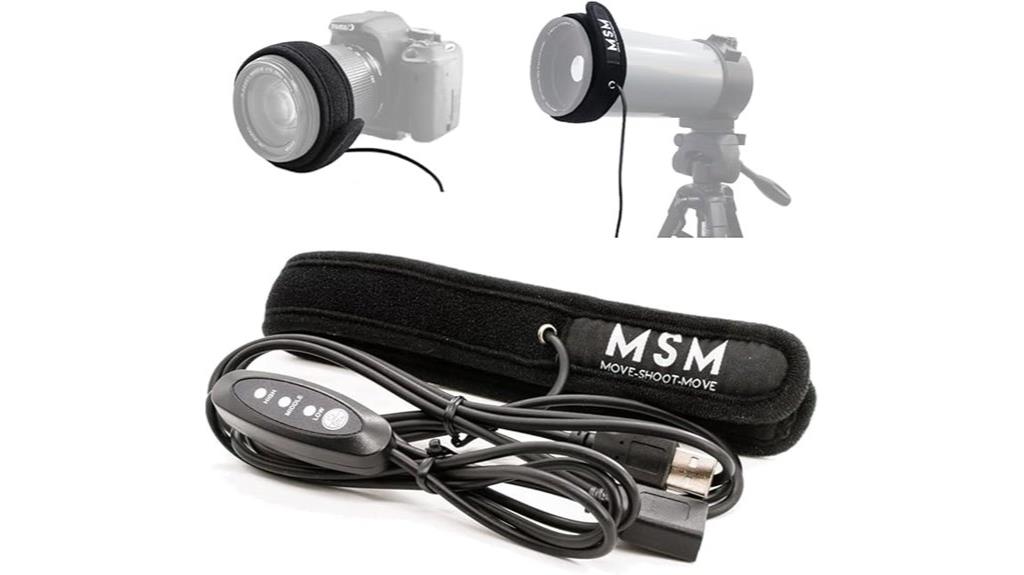
A standout choice for astrophotographers and telescope enthusiasts facing cold, humid conditions is the Lens Warmer with Cold Flexible Cable. Its 350mm neoprene strip is designed to prevent dew, fog, and condensation on lenses and telescopes, even in temperatures down to -25°C. The flexible, lightweight material easily wraps around larger lenses or scopes, secured with an adhesive strap. It heats quickly to about 75°C and offers adjustable temperature settings via a USB power cable. Powered by portable power banks, it’s perfect for outdoor use. Customers praise its reliability, easy setup, and effective dew prevention, making it a valuable tool for long astrophotography sessions.
Best For: astrophotographers and telescope enthusiasts who need an effective dew prevention solution in cold and humid outdoor conditions.
Pros:
- Rapid heating up to 75°C with adjustable temperature settings for customized use.
- Flexible neoprene strip easily wraps around larger lenses and telescopes, ensuring a snug fit.
- Powered via USB with long cable, making it convenient for outdoor use with portable power banks.
Cons:
- Outer side insulation could be improved to reduce heat loss and enhance efficiency.
- Some users desire more elastic straps for a tighter, more secure fit.
- Longer cable length might be cumbersome for certain setups or storage.
Dew Heater Strip for 9–10” Telescopes
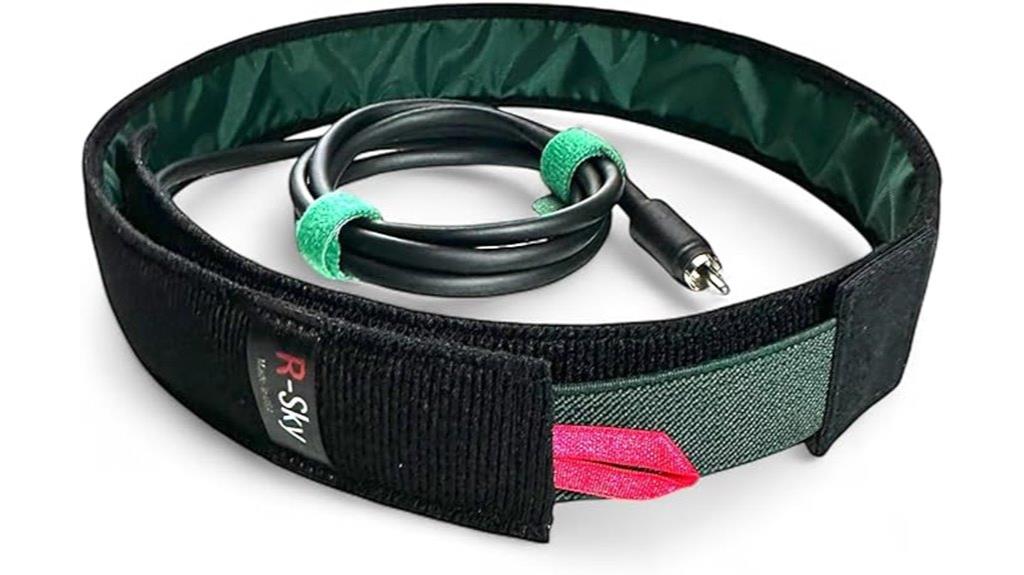
If you’re using a 9–10” telescope and need reliable dew prevention, the Dew Heater Strip offers a high-power, even heating solution designed specifically for your optical size. Compatible with Schmidt-Cassegrain, Maksutov-Cassegrain, and astrograph designs, it keeps your optics clear during humid conditions. The durable, flexible 47-inch cord remains soft in cold weather, preventing knots during setup. Its uniform surface heating ensures no hot spots, maintaining consistent warmth across your optical tube. Built and tested by R-Sky for quality, it connects easily with standard 12V power supplies, making extended observing sessions hassle-free and dew-free.
Best For: astronomers using 9–10” telescopes who need reliable dew prevention to maintain clear optics during extended observing sessions.
Pros:
- Provides high-power, even heating to prevent dew buildup effectively.
- Compatible with popular optical designs like Schmidt-Cassegrain, Maksutov-Cassegrain, and astrograph.
- Durable, flexible cord remains soft in cold weather, preventing knots and ensuring easy setup.
Cons:
- Designed specifically for 9–10” telescopes, not suitable for smaller or larger sizes.
- Requires a compatible 12V power source or dew controller for operation.
- May need additional accessories or controllers for optimal performance in some setups.
USB Lens Warmer with Temperature Regulator for Telescope and DSLR Lenses

The USB Lens Warmer with Temperature Regulator is an excellent choice for astronomers and photographers who need a reliable solution to prevent condensation on their lenses in cold conditions. It’s compatible with telescope and DSLR lenses under 80mm in diameter, making it versatile for various setups. The warmer features a 1.5-meter regulator with low, medium, and high modes, capable of withstanding temperatures as low as -40°C. Made from high-quality materials, it heats quickly and insulates effectively without impacting image quality. Powered via USB, it’s easy to install and adjust, ensuring clear, fog-free views whether you’re observing or capturing astrophotos outdoors.
Best For: amateur astronomers and outdoor photographers seeking an effective, portable solution to prevent lens fogging in cold environments.
Pros:
- Quick and efficient heating with high-quality thermal insulation materials.
- Adjustable 1.5-meter regulator with multiple heat modes suitable for various conditions.
- USB-powered for easy compatibility with power banks and USB outlets, ideal for outdoor use.
Cons:
- Suitable only for lenses with diameters less than 80mm, limiting larger lens compatibility.
- May ship with different versions in appearance due to design updates, though functionality remains consistent.
- Limited to temperature regulation without additional features like remote control or app integration.
Dew Heater Strip for Telescopes (6 inch)

Dew heater strips for 6-inch telescopes are ideal for amateur astronomers and astrophotographers who need reliable dew prevention during chilly, humid nights. These strips from R-Sky are designed to prevent dew, fog, and frost on your telescope’s optics, ensuring clear views. They’re compatible with various telescope types, including refractors, Schmidt-Cassegrain, Maksutov-Cassegrain, Newtonians, and RASA models. Made with special materials for even heat distribution, they prevent hotspots and overheating. Paired with a dew heater controller, they offer customizable performance. Their durable, flexible RCA cords resist cold and tangling, making these strips a dependable choice for maintaining *ideal* viewing conditions throughout your night session.
Best For: amateur astronomers and astrophotographers using 6-inch telescopes who need reliable dew prevention during cold, humid nights.
Pros:
- Ensures clear optics by preventing dew, fog, and frost on telescope lenses
- Compatible with multiple telescope types including refractors and Schmidt-Cassegrain models
- Made with durable, flexible RCA cords that resist cold temperatures and tangling
Cons:
- Requires a compatible dew heater controller for optimal performance
- May need to purchase the correct size for specific telescope diameters
- Hand-assembled components might lead to slight variability in quality or performance
250mm DC Lens Heater Warmer Dew Heater Strip for Telescopes and Camera Lenses
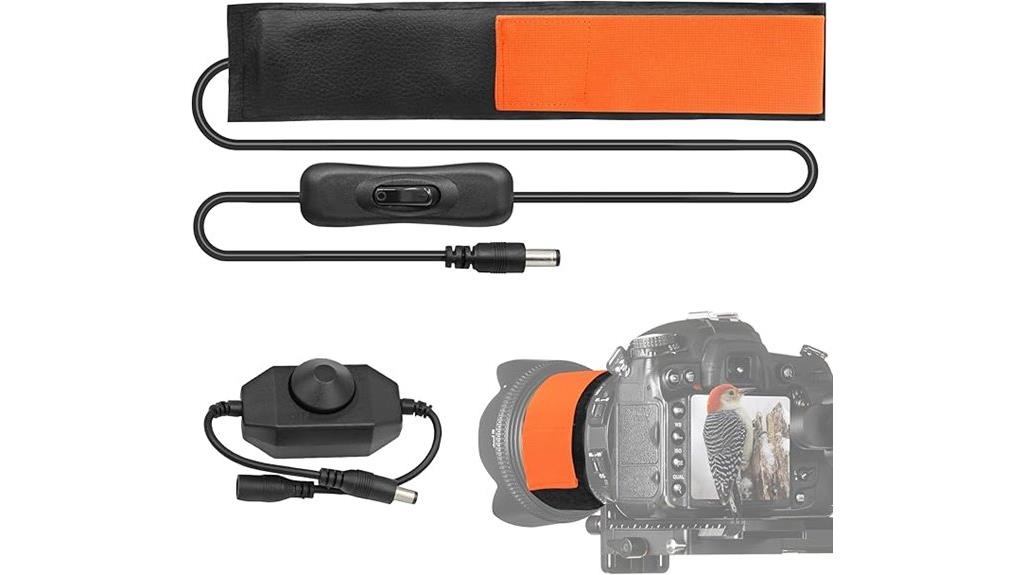
Designed for lenses with an outer diameter less than 80mm, the mm DC Lens Heater Warmer Dew Heater Strip is ideal for amateur astronomers and photographers seeking an affordable, portable way to prevent fogging and dew. It features stepless temperature regulation via a sliding knob, giving precise control over heat levels. Powered by a DC port, it’s compatible with power banks or other DC sources, making outdoor use convenient. The compact size (about 5.5 x 1.97 x 3.19 inches) and lightweight design (around 4.2 ounces) make it easy to attach and carry. Users find it effective at preventing dew, especially in cold weather, at a budget-friendly price.
Best For: amateur astronomers and photographers seeking an affordable, portable solution to prevent fogging and dew on lenses under cold or humid conditions.
Pros:
- Adjustable stepless temperature control for precise heat regulation
- Compatible with power banks and portable DC sources for outdoor use
- Compact and lightweight design makes it easy to attach and carry
Cons:
- Rated as a lower-end dew heater, suitable mainly for moderate use
- May draw slightly over 2 amps at maximum setting, requiring careful power management
- Limited to lenses with an outer diameter less than 80mm, restricting applicability to larger lenses
Astromania USB Lens Warmer Heater for Telescope and Camera
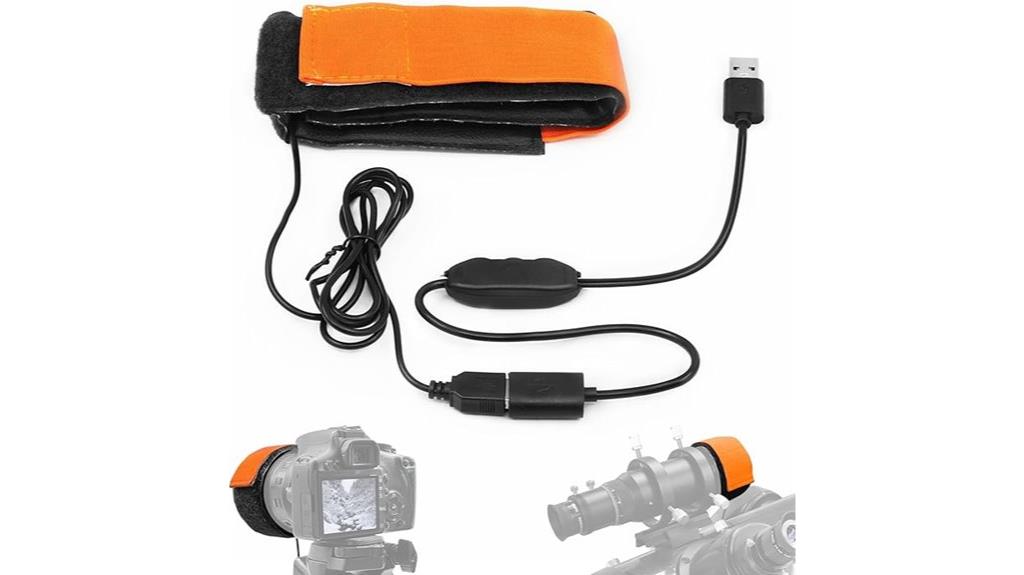
If you’re looking for a versatile solution to prevent fogging and freezing on your lenses during outdoor astrophotography, the Astromania USB Lens Warmer Heater is an excellent choice. This 25cm strip offers stepless temperature regulation, making it compatible with lenses under 80mm in diameter. It’s perfect for telescopes, cameras, or other optics, ensuring clear images in humid or cold conditions. The USB connection allows easy powering from power banks, making setup simple and portable. Beyond astrophotography, it can warm water bottles or serve as a cold-weather shield, providing practical multi-use functionality for outdoor enthusiasts.
Best For: outdoor astrophotographers and telescope users seeking an effective, portable solution to prevent lens fogging and freezing in cold or humid conditions.
Pros:
- Stepless temperature regulation allows precise control for optimal lens heating
- USB-powered design offers convenient, portable operation with power banks
- Versatile use beyond lens warming, including water bottle and cold-weather protection
Cons:
- Suitable only for lenses with diameters under 80mm, limiting compatibility with larger equipment
- May require additional accessories for optimal fit on certain telescope models
- Continuous power source needed for operation, which could limit mobility without sufficient power banks
NEEWER USB Lens Heater for DSLR and Telescopes
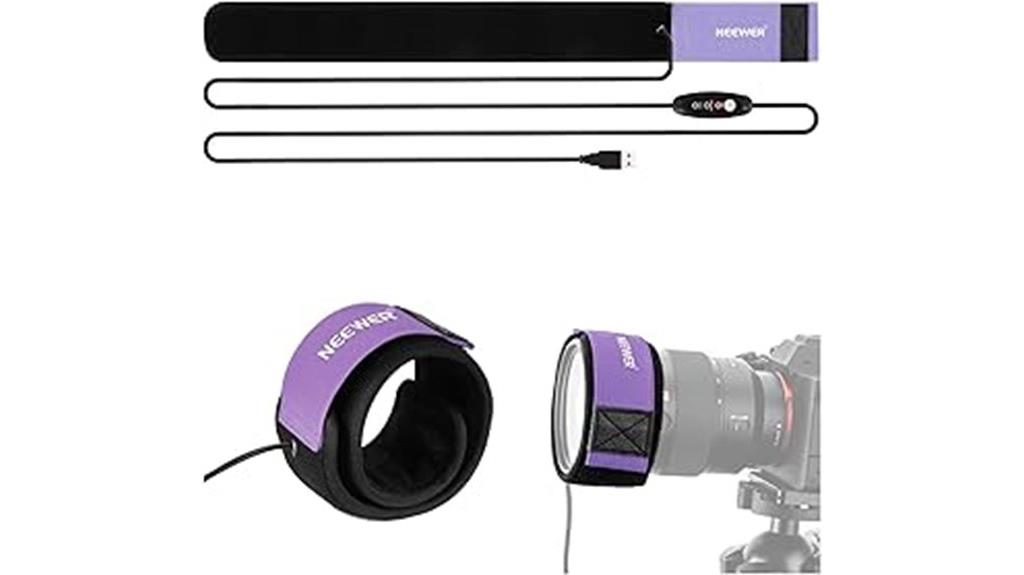
For astronomers and astrophotographers seeking a reliable, easy-to-use solution to prevent dew buildup on their lenses and telescopes, the NEEWER USB Lens Heater stands out as an excellent choice. It’s designed for DSLR lenses and telescopes, offering quick, even heating with advanced FPC technology. Powered via a standard 5V USB port, it includes overheating and overvoltage protections for safety. Its flexible, lightweight build wraps securely around lenses up to 12 inches in circumference using a touch fastener. With three adjustable temperature settings, it provides versatile dew prevention, making it a practical and convenient accessory for clear, bright views during your night sky adventures.
Best For: astrophotographers, astronomers, and DSLR users seeking an easy-to-use solution to prevent dew on lenses and telescopes during night sky observations.
Pros:
- Quick, even heating with advanced FPC technology for reliable dew prevention.
- Flexible and lightweight design that wraps securely around lenses up to 12 inches in circumference.
- Powered via standard 5V USB port with built-in overheating and overvoltage protections for safe operation.
Cons:
- Cannot be folded, only bent to fit around lenses.
- Suitable for lenses up to 12 inches in circumference; larger lenses may require a different solution.
- Limited to three temperature settings, which may not suit all environmental conditions.
Extra Big Dew Heater Strip for Large Telescopes
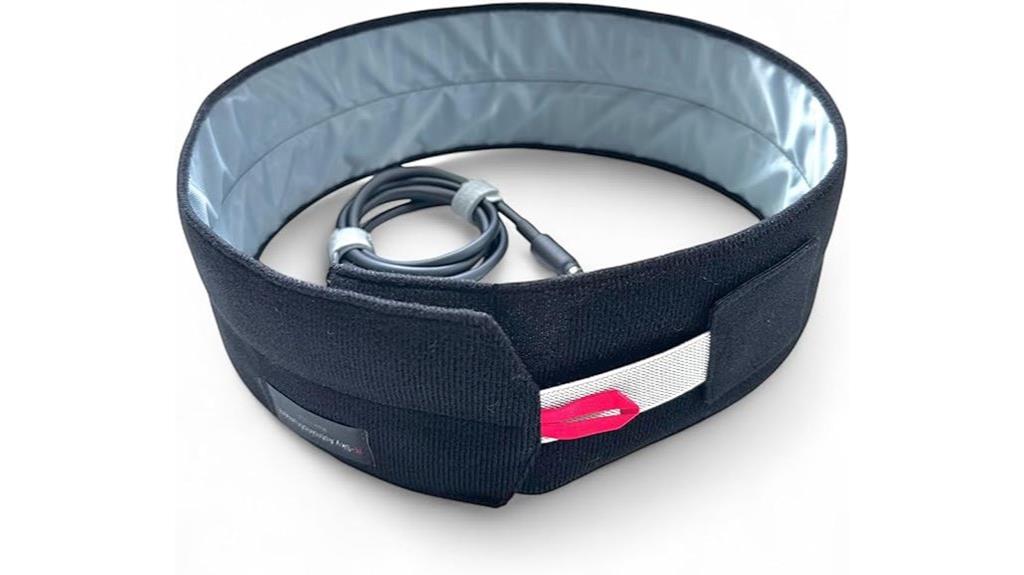
The Extra Big Dew Heater Strip is an ideal choice for astronomers with large telescopes, as it provides strong, even heating across surfaces ranging from 7 to 16 inches. It’s specifically designed for larger models, like 9-10 inch telescopes, ensuring thorough dew protection. Hand-assembled for durability, it features a 47-inch flexible, tangle-free power cord compatible with RCA 12V dew controllers. You can easily adjust the heat levels with a controller to optimize energy use and battery life. R-Sky’s reliable, field-tested design offers consistent performance, making it a dependable solution to keep your large telescope clear and dew-free during those chilly nights.
Best For: astronomers with large telescopes (7-16 inches) seeking reliable dew prevention during high humidity conditions.
Pros:
- Provides strong, even heating across full surface for thorough dew protection
- Compatible with RCA 12V dew controllers for easy heat level adjustments
- Hand-assembled for durability with a flexible, tangle-free 47-inch power cord
Cons:
- Designed primarily for 7–16 inch telescopes, less suitable for smaller models
- Requires a compatible controller for optimal use, adding to setup complexity
- May need multiple strips for very large or multiple telescope setups
Factors to Consider When Choosing Dew Heaters for Telescopes
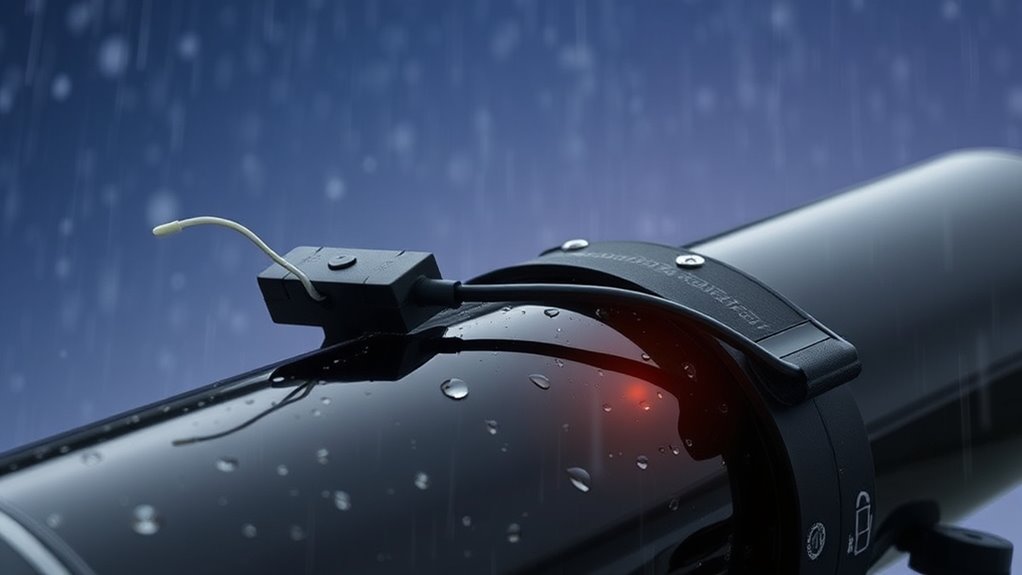
When choosing a dew heater, I consider how well it matches my telescope’s equipment and the power sources I have available. I also look at its heating efficiency, size, and durability to make certain it works reliably in different conditions. These factors help me pick a heater that keeps my optics clear without any hassle.
Compatibility With Equipment
Choosing a dew heater that matches your telescope’s specific equipment is crucial for effective dew prevention. First, verify the heater suits your telescope’s diameter and type, whether SCT, Maksutov, Newtonian, or refractor, to provide proper coverage. Check that the power connector and voltage specifications align with your existing power sources and dew controller system to avoid compatibility issues. Select a heater with the right size and shape—such as strips, rings, or pads—tailored to your optical surface or lens dimensions. Additionally, review the mounting method—Velcro, adhesive, or clips—to ensure secure attachment suited to your equipment’s material. Finally, confirm that the heater’s operating temperature range and control features match your observing or imaging environment, preventing dew without risking damage.
Heating Power Efficiency
To guarantee your dew heater works efficiently, it’s essential to take into account how much power it consumes and how effectively it distributes heat. Higher wattage heaters can warm optics quickly and reduce dew formation, but they may also draw more power. It’s important that the heater distributes heat evenly to avoid hot spots that could damage equipment or cause uneven dew prevention. Models that optimize energy use are better—they maintain proper temperatures longer without wasting power. Proper insulation and heat retention features help conserve energy by minimizing heat loss, ensuring consistent performance during long observing sessions. Additionally, the size and surface coverage of the heater matter; larger surface areas provide more effective dew prevention, making your setup more efficient overall.
Size and Fit
Selecting the right dew heater hinges on making certain it fits your telescope properly; an ill-fitting heater can be ineffective or even cause damage. First, measure the outer diameter of your telescope or lens to choose a heater strip or ring that fits snugly without obstructing the view or focusing. For irregularly shaped optics or larger telescopes, consider larger or contoured heaters designed for uniform coverage. Adjustable or flexible heater designs are versatile, allowing customization across different instruments. Always check that the heater’s size matches your telescope’s dimensions to prevent gaps that could lead to dew formation or excess material that might interfere with operation. Proper sizing guarantees effective dew prevention while maintaining peak performance and safety during observing sessions.
Power Source Compatibility
Making certain your dew heater is compatible with your power source is essential for safe and reliable operation. First, check if the heater works with your available power supply, such as 12V DC, USB, or DC adapters, to avoid connection issues. Make sure the voltage and current requirements match your power source to prevent underperformance or damage. Also, verify that the heater supports your preferred delivery method—whether it’s portable power banks, dew controllers, or standard AC/DC adapters. Consider the length and connector type of the power cord to ensure it reaches your setup comfortably. Finally, confirm that the dew heater’s input specifications align with your electrical system, ensuring safe operation and consistent performance during your observing sessions.
Durability and Build
When choosing a dew heater, the durability and build quality play a vital role in its performance and longevity. I look for units made from weather-resistant materials like silicone, neoprene, or reinforced aluminum, which can handle harsh outdoor conditions. Flexible power cords and fasteners that resist low temperatures are essential, ensuring they stay pliable and tangle-free in cold weather. Hand-assembled units often deliver better quality control, leading to more consistent performance and a longer lifespan. Insulation layers, such as three-layer insulation, help minimize heat loss and protect internal components from environmental stressors. Additionally, secure attachment mechanisms like velcro or tough fasteners ensure the heater stays firmly in place without damaging delicate telescope surfaces. Durability truly impacts the long-term effectiveness of a dew heater.
Temperature Control Options
Temperature control options are essential because they directly impact how effectively a dew heater prevents condensation without risking damage to your telescope. Adjustable temperature settings let me customize the heat output based on current conditions, ensuring I avoid overheating the optics. Many models offer multiple heating modes—low, medium, and high—so I can fine-tune the level of dew prevention as humidity and temperatures shift. Stepless regulation provides smooth, continuous adjustments, giving me precise control for maximum performance. Some advanced heaters incorporate thermistors or thermocouples to automatically maintain a set temperature, reducing the need for constant manual tweaks. Effective temperature control helps protect delicate components and guarantees consistent dew prevention, no matter how variable the weather gets.
Ease of Installation
Choosing a dew heater that’s easy to install can save a lot of frustration during setup and nighttime observations. Look for models with simple mounting options like Velcro straps or adjustable fasteners, which work well with various telescope sizes and shapes. Compatibility with your existing power supplies and controllers is essential, so check that the heater can connect seamlessly without extra adapters. Flexible, tangle-free wiring makes positioning straightforward and prevents setup headaches outdoors. Clear, accessible controls, such as adjustable temperature settings or pre-set modes, also make operation more intuitive. Additionally, a lightweight design reduces the risk of imbalance and makes it easier to attach and remove the heater quickly. Overall, an easy-to-install dew heater streamlines your setup and helps you focus on stargazing.
Price and Value
Dew heater prices vary widely, from budget options around $10 to premium models over $50, depending on size, power, and build quality. While cheaper heaters may cover basic dew prevention, they often lack advanced features like precise temperature control or durable construction. Higher-value models typically offer adjustable settings, robust materials, and universal compatibility, providing better long-term performance. Investing in a heater with positive customer reviews and a reliable warranty can save money by ensuring durability and effectiveness. Striking a balance between price and features is key; a more expensive heater with better build quality and controls can prevent frequent replacements and ensure consistent dew prevention. Ultimately, choosing a heater with good value means prioritizing durability, performance, and compatibility over just the lowest cost.
Frequently Asked Questions
How Do Dew Heaters Prevent Moisture Buildup on Telescope Lenses?
Dew heaters prevent moisture buildup on telescope lenses by providing gentle, consistent heat that keeps the lens temperature above the dew point. I attach the heater around the lens or corrector plate, and it automatically adjusts to maintain a steady temperature. This prevents condensation from forming, ensuring my view stays clear and bright during chilly nights. It’s a simple but effective way to protect my equipment and enjoy uninterrupted stargazing.
What Is the Ideal Power Source for Portable Dew Heater Setups?
Think of a reliable partner like a trusty lantern in the dark—my ideal power source for portable dew heaters is a portable power bank or a 12V battery. They’re lightweight, versatile, and easy to carry, ensuring I never lose sight of my target. With ample capacity, they keep my heater running smoothly all night, much like a steady flame guiding my way through the night’s mysteries.
How Do Temperature Regulators Enhance Dew Heater Performance?
Temperature regulators improve dew heater performance by maintaining a consistent, ideal temperature over your telescope’s lens. I use one because it prevents overheating and minimizes power waste, ensuring clear views without damaging my equipment. They automatically adjust power output based on real-time temperature readings, which means I don’t have to constantly monitor and tweak settings manually. This makes my observing sessions more reliable, comfortable, and hassle-free.
Can Dew Heaters Be Used Simultaneously on Multiple Telescope Accessories?
Absolutely, I can use dew heaters on multiple accessories at once, and it’s like having a warm breeze gently warding off moisture across your entire setup. I simply connect each accessory to its own controller or use a multi-channel one, ensuring everything stays clear and dew-free. This way, I enjoy uninterrupted stargazing, with every lens and finder shielded from fog, providing a bright, crisp view of the cosmos.
What Safety Precautions Should Be Taken When Operating Dew Heaters?
When operating dew heaters, I always ensure I follow safety precautions. I double-check that all connections are secure and avoid overloading power sources. I use a controller with a temperature limit to prevent overheating. It’s also vital to keep cables organized to avoid tangles or damage, and I disconnect the heater when not in use. Wearing gloves helps protect my hands, and I always operate in a dry environment to prevent electrical hazards.
Conclusion
Did you know that using a quality dew heater can extend your telescope viewing time by up to 50%? Investing in the right dew heater guarantees your view stays clear and bright, even in the dampest conditions. With options like the Celestron Dew Heater Ring or SVBONY strips, you’ll never miss a detail due to dew. Keep your skies crystal clear and your nights unforgettable—choose the right dew heater today!
